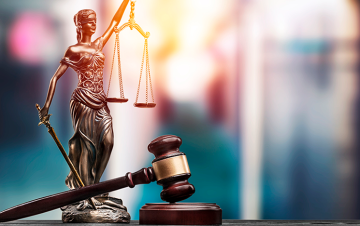I am studying in the third year of the State University of Economics and Technology.I specialize in contractual, economic and corporate law, in particular, I provide consultations and write articles.
A counterclaim is a procedural means by which the defendant in the case files a lawsuit against the plaintiff. This allows the defendant to protect his rights and interests by making his own demands against the person who initiated the case.
Characteristics of the counterclaim
- Grounds for filing: A counterclaim may be filed if the defendant has independent claims against the plaintiff, which are of a legal nature and closely related to the subject of the original claim.
Filing Procedure: A counterclaim is filed as part of an existing lawsuit. The defendant files a counterclaim with the court in which the original claim is being considered.
Relationship to the original claim: The counterclaim must be closely related to the original claim. This means that the facts and circumstances on which the counterclaim is based must be related to the subject of the primary claim.
Deadline for filing a counterclaim:
After the court makes a decision to open proceedings in the case, the court notifies all parties, including the defendant, about it. The decision on the opening of proceedings is a document that determines the term for filing a counterclaim. The defendant has the opportunity to file a counterclaim within the time limit set by the court. This period cannot be less than fifteen days from the moment of delivery of the decision to open proceedings.
Content of the counterclaim:
The statement of claim is the main document in the civil process, which is submitted to the court to initiate the consideration of the case. It must be prepared in writing and contain certain mandatory details that ensure the correct consideration of the case. Here is a brief description of the components of the statement of claim:
- Name of the court: Indication of the court of first instance to which the claim is filed.
Information about the parties and participants in the case: For legal entities: Full name, location, identification code in the Unified State Register. - For individuals: Name (surname, first name, patronymic), place of residence, postal code, registration number of the taxpayer's registration card or passport number and series (if available), status (individual entrepreneur), contact data.
Price of the claim and calculation of amounts: If the claim is subject to a monetary assessment, it is necessary to indicate the price of the claim and a reasonable calculation of the amounts charged or disputed.
Content of claims: Description of ways to protect rights or interests, which the plaintiff asks the court to determine in the decision. If the lawsuit is filed against several defendants, indicate the requirements for each of them.
Circumstances and evidence: A statement of the circumstances justifying the claims, the legal grounds of the claim. Specify evidentiary materials confirming these circumstances.
Pre-trial settlement of the dispute: Information on the measures taken for the pre-trial settlement of the dispute, if it is provided by law.
Preservation of evidence or claim: Details of the measures taken to secure evidence or claim before filing a claim.
List of documents and evidence: List of documents and other evidence attached to the statement of claim. If some documents are not submitted with the claim, state the reasons. Also indicate the availability of original documents, copies of which are attached.
Procedure for filing a counterclaim:
The procedure for filing a counterclaim in a commercial proceeding has its own characteristics, which may differ depending on the jurisdiction. In Ukraine, the economic process is regulated by the Economic Procedural Code (CPC). Here is a detailed description of the main stages and features of filing a counterclaim in an economic process in accordance with Ukrainian legislation:
- Preparing to file a counterclaim: Before filing a counterclaim, it is important to assess the legal validity of your claims and the relationship between the original claim and the counterclaim.
Consultation with a lawyer: It is recommended to contact a lawyer or an attorney to prepare legal documentation and justify the requirements.
Drafting a counterclaim: It is worth noting that the counterclaim is subject to the requirements regarding the statement of claim and the documents attached to it. It is important to take into account all statutory requirements, because if violations are committed, the lawsuit will remain motionless.
Filing a counterclaim: A counterclaim is filed in the same court as the original lawsuit.
Consideration of the counterclaim: The court considers the counterclaim together with the original claim. All procedural actions, including submission of evidence and objections, are carried out within the framework of one proceeding if the primary and counterclaim are interconnected and arise from the same legal relationship.
Making a decision: The court makes a decision on both claims, which makes it possible to comprehensively solve the case and ensure justice.
Execution of the court decision: The court decision, adopted on the primary and counterclaims, is binding. If the parties do not comply with the decision voluntarily, enforcement proceedings may be initiated.
Legal assistance in filing a counterclaim
The help of a lawyer when filing a counterclaim is important to ensure the correctness and efficiency of the process. Here's how a lawyer can help at various stages of filing a counterclaim:
- Consultation and situation assessment:
Assessment of legal grounds: The lawyer will help assess the legal basis for filing a counterclaim, will check whether there are grounds for bringing forward one's own claims against the plaintiff.
Analysis of the original claim: The lawyer will carefully study the original claim in order to understand its requirements and circumstances that may affect the preparation of the counterclaim.
- Preparation of documents:
Drafting of the counterclaim: The lawyer will prepare the text of the counterclaim, including all the necessary details, such as the name of the court, details of the parties, content of claims, circumstances and evidence.
Legal reasoning: The lawyer will provide the legal reasoning for the claims made in the counterclaim and prepare the relevant legal arguments.
- Collection and evaluation of evidence:
Gathering evidence: The lawyer will help gather all the necessary documents and evidence that support the claims in the counterclaim.
Evaluation of evidence: The lawyer will evaluate the strength and weight of the available evidence, will help determine which documents and testimonies are the most convincing.
- Filing of a lawsuit and procedural actions:
Filing a claim: The lawyer will ensure that the counterclaim is properly submitted to the court, complying with all procedural requirements and deadlines.
Pleadings: The lawyer will prepare and file all necessary pleadings, such as subpoenas or motions.
- Participation in a court hearing:
Court proceedings: A lawyer represents the client's interests in court, provides collected evidence, asks questions of witnesses and presents arguments.
Representation of a lawyer in court: The lawyer prepares the client for court hearings, explains the procedure and possible strategies.
- Legal proceedings and consultations:
Defense in court: The lawyer develops a strategy for the effective protection of the client's rights and formulates a position regarding the counterclaim, the lifting of arrest (if it was imposed) and other measures.
Settlement Advice: A lawyer in court provides advice on possible dispute settlement before or during litigation, including mediation or negotiation.
In general, a counterclaim is an important tool to ensure a fair trial and resolution of disputes between the parties. A counterclaim must be filed within the prescribed time limits and meet certain requirements of procedural legislation. lawyer's representation in court ensures the correct drafting and submission of a counterclaim, which can significantly affect the outcome of the case and the protection of the rights and interests of the client.




































